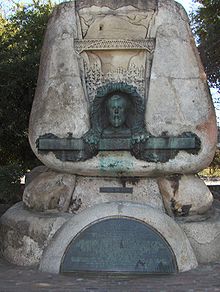- Theodore Judah
-
Theodore Dehone Judah 
Born March 4, 1826
Bridgeport, ConnecticutDied November 2, 1863 (aged 37) Cause of death Yellow Fever Other names Crazy Judah Occupation engineer Known for Being A Central Pacific Railroad engineer Theodore Dehone Judah (March 4, 1826–November 2, 1863) was an American railroad engineer who dreamed of the first Transcontinental Railroad. He found investors for what became the Central Pacific Railroad (CPRR). As chief engineer, he performed much of the land survey work to determine the best possible route for the railroad over the Sierra Nevada mountains.
Contents
Early life and education
Theodore Judah was born in 1826 in Bridgeport, Connecticut, the son of an Episcopal clergyman. After his family moved to Troy, New York, Judah studied engineering at Rensselaer Polytechnic Institute.
On May 10, 1847 at age 21, Judah married Anne Pierce. Twenty-two years later, to the day, some six years after Judah's death, the "golden spike" was driven, completing the Transcontinental Railroad.
Career
After working on a number of railroads in the Northeast, Judah was hired as the Chief Engineer for the Sacramento Valley Railroad in California. It was the first railroad built west of the Mississippi River. Throughout the 1850s, Judah was known as "Crazy Judah" for his idea to build a railroad through and over the wall of mountains known as the Sierra Nevada, a project which many people at the time considered impossible.
CPRR
As the chief engineer of the Central Pacific Railroad, Judah surveyed the route over the Sierra Nevada along which the railroad was to be built during the 1860s. Failing to raise funds for the project in San Francisco, he succeeded in signing up four Sacramento merchants—the "Big Four": Leland Stanford, Collis P. Huntington, Mark Hopkins, and Charles Crocker. They managed financing and construction of the CPRR.
With their backing, Judah lobbied for federal authorization and government financing of the transcontinental railroad in Washington, D.C.. He contributed to the passage of the 1862 Pacific Railroad Act, which authorized construction of the First Transcontinental Railroad. After passage of the 1862 Act, the Big Four marginalized Judah. They put Crocker in charge of construction. Construction was completed in 1869, with virtually the entire course of the railroad having followed Judah's plans.
Early death
Judah died of yellow fever (then known as Panama fever). He caught the disease in Panama while taking a ship voyage with his wife to New York City, apparently becoming infected during their land passage across the Isthmus of Panama. They were going to New York for him to seek alternative financing to buy out the Big Four investors.
Legacy and Honors
- The CPRR named one of its steam locomotives (CP No. 4) after him. Judah crossed paths with the 19-ton locomotive bearing his name while on his way to New York.
- Judah Street in San Francisco and its N-Judah Muni streetcar line are named after him.
- Memorial plaques dedicated to him have been erected in Folsom and Sacramento.
- Schools have been named after Judah.
Within days of Judah's death, the CPRR's first locomotive, Gov. Stanford, made a trial run over the new railroad's first 500 feet of track.
Historical analysis
Historians have been sharply divided over his legacy. They agree that he had a vision, and his optimism helped popularize the remarkable plan of building a transcontinental railroad, convinced the Big Four to finance it, and was instrumental in securing Congressional passage of the 1862 law.
See also
- California and the railroads
- N Judah
References
- Ambrose, Stephen E. (2000). Nothing Like It In The World; The men who built the Transcontinental Railroad 1863-1869. Simon & Schuster. ISBN 0-684-84609-8.
- David Haward Bain, Empire Express: Building the First Transcontinental Railroad (2000)
- John Debo Galloway; The First Transcontinental Railroad: Central Pacific, Union Pacific (1950)
- Theodore Henry Hittell, History of California (1898) vol 4
- White, John H., Jr. (Spring 1986). "America's most noteworthy railroaders". Railroad History 154: pp. 9–15. ISSN 0090-7847. OCLC 1785797.
External links
Categories:- 1826 births
- 1863 deaths
- People from Bridgeport, Connecticut
- Deaths from yellow fever
- 19th-century American railroad executives
- Rensselaer Polytechnic Institute alumni
- Infectious disease deaths in Panama
- American surveyors
- Robber barons
- People of Upstate New York
Wikimedia Foundation. 2010.


